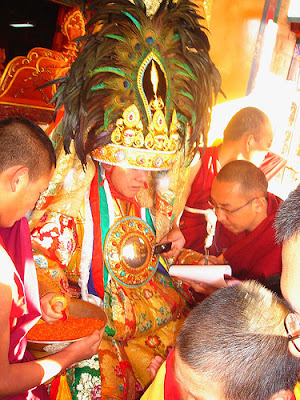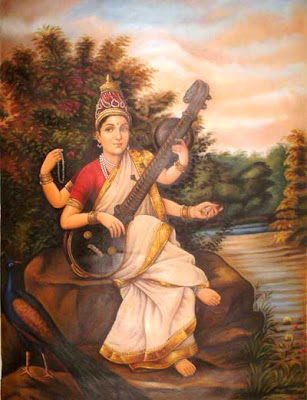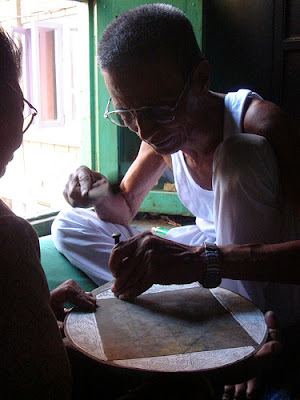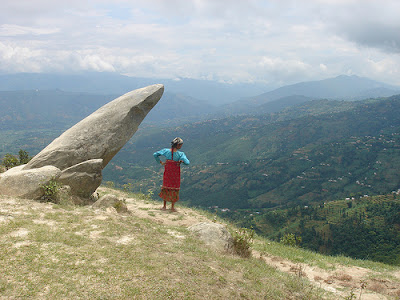Turn and face the strange
Kathmandu, Nepal
Well, I won't be back in India on 16th February, after all. Turns out my heart-homegirl and living legend Ani Tenzin Palmo (nee Diane Perry) is getting enthroned as a Je Tsun Ma right here in K-town on the 16th.
That's right, all holy an' stuff....a first for a western woman. Tenzin Palmo's mission in this lifetime has been to revive
the lost lineage of TogdenMas (kick-ass, hardcore longhaired female yoginis). This lineage was lost after the Tibetan Exile in 1959.
I was fortunate enough to meet Tenzin Palmo last year at the Tashi Dzong Monastery masked dances in Himachal Pradesh. She is best known via the biography written by Vickie MacKenzie, Cave In the Snow, which is a sort of end-users' manual for following your heart. Everyone told her she couldn't do it, it had never been done before...against all the rules and traditions, blah blah blah....and here we are 25 years later getting enthroned, for crying out loud.
 When I met her (photo above), while bathing in her considerable aura, all I could think was: Amazing, that a woman who spent 12 years in a snowbound cave in the Lahauli mountains is so totally normal - more well-adjusted than most of us. The burning eye
When I met her (photo above), while bathing in her considerable aura, all I could think was: Amazing, that a woman who spent 12 years in a snowbound cave in the Lahauli mountains is so totally normal - more well-adjusted than most of us. The burning eyeNow I'm going to go off on the mystical tip. My friend Robert hates it when I do this....but Kathmandu is like that sometimes.
Thus I heard. On one occasion the Blessed One was living at Gaya, at Gayasisa, together with a thousand bhikkhus. There he addressed the bhikkhus.
"Bhikkhus, all is burning. And what is the all that is burning?
"The eye is burning, forms are burning, eye-consciousness is burning, eye-contact is burning, also whatever is felt as pleasant or painful or neither-painful-nor-pleasant that arises with eye-contact for its indispensable condition, that too is burning. Burning with what? Burning with the fire of lust, with the fire of hate, with the fire of delusion. I say it is burning with birth, aging and death, with sorrows, with lamentations, with pains, with griefs, with despairs.
"The ear is burning, sounds are burning...
"The nose is burning, odors are burning...
"The tongue is burning, flavors are burning...
"The body is burning, tangibles are burning...
"The mind is burning, ideas are burning, mind-consciousness is burning, mind-contact is burning, also whatever is felt as pleasant or painful or neither-painful-nor-pleasant that arises with mind-contact for its indispensable condition, that too is burning.
Burning with what? Burning with the fire of lust, with the fire of hate, with the fire of delusion. I say it is burning with birth, aging and death, with sorrows, with lamentations, with pains, with griefs, with despairs.
"Bhikkhus, when a noble follower who has heard (the truth) sees thus, he finds estrangement in the eye, finds estrangement in forms, finds estrangement in eye-consciousness, finds estrangement in eye-contact, and whatever is felt as pleasant or painful or neither-painful- nor-pleasant that arises with eye-contact for its indispensable condition, in that too he finds estrangement.
"He finds estrangement in the ear... in sounds...
"He finds estrangement in the nose... in odors...
"He finds estrangement in the tongue... in flavors...
"He finds estrangement in the body... in tangibles...
"He finds estrangement in the mind, finds estrangement in ideas, finds estrangement in mind-consciousness, finds estrangement in mind-contact, and whatever is felt as pleasant or painful or neither-painful-nor-pleasant that arises with mind-contact for its indispensable condition, in that too he finds estrangement.
"When he finds estrangement, passion fades out. With the fading of passion, he is liberated. When liberated, there is knowledge that he is liberated. He understands: 'Birth is exhausted, the holy life has been lived out, what can be done is done, of this there is no more beyond.'"
That is what the Blessed One said. The bhikkhus were glad, and they approved his words.
Now during his utterance, the hearts of those thousand bhikkhus were liberated from taints through clinging no more.
 dropping. Shameless, sycophantic name-dropping. Why didn't I think of that before? The Dalai Lama wasn't important enough. I had to go over his head, with this visa thing. Anyways, not to speak to soon, but looks like we have some progress on that front.
dropping. Shameless, sycophantic name-dropping. Why didn't I think of that before? The Dalai Lama wasn't important enough. I had to go over his head, with this visa thing. Anyways, not to speak to soon, but looks like we have some progress on that front.  last August, "Wireless in Kathmandu") is officially over. Last year their wireless was free in the coffee shop. It has since gone from free to 161NRs per hours - quite a jump.
last August, "Wireless in Kathmandu") is officially over. Last year their wireless was free in the coffee shop. It has since gone from free to 161NRs per hours - quite a jump.  Kesar Mahal in Thamel. Wireless is still free here; you might have a problem finding an outlet that works, but the garden is beautiful.
Kesar Mahal in Thamel. Wireless is still free here; you might have a problem finding an outlet that works, but the garden is beautiful.  Yeti will provide wireless for everyone, including outside guests, for 1000NRs (or about $15) a day. Pack a lunch! Hotel Shangri-La's is beyond the pale, at 275NRs (or about $5.00 US) an hour.
Yeti will provide wireless for everyone, including outside guests, for 1000NRs (or about $15) a day. Pack a lunch! Hotel Shangri-La's is beyond the pale, at 275NRs (or about $5.00 US) an hour.
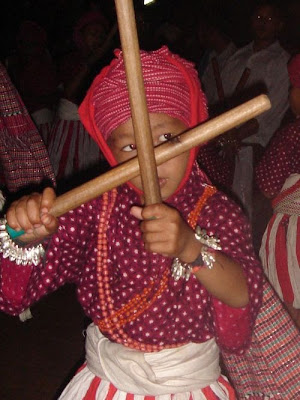








 : Twilight falls on Pashupatinath as seen from the Mrigasthali (Deer Forest), Kathmandu, 2006
: Twilight falls on Pashupatinath as seen from the Mrigasthali (Deer Forest), Kathmandu, 2006

